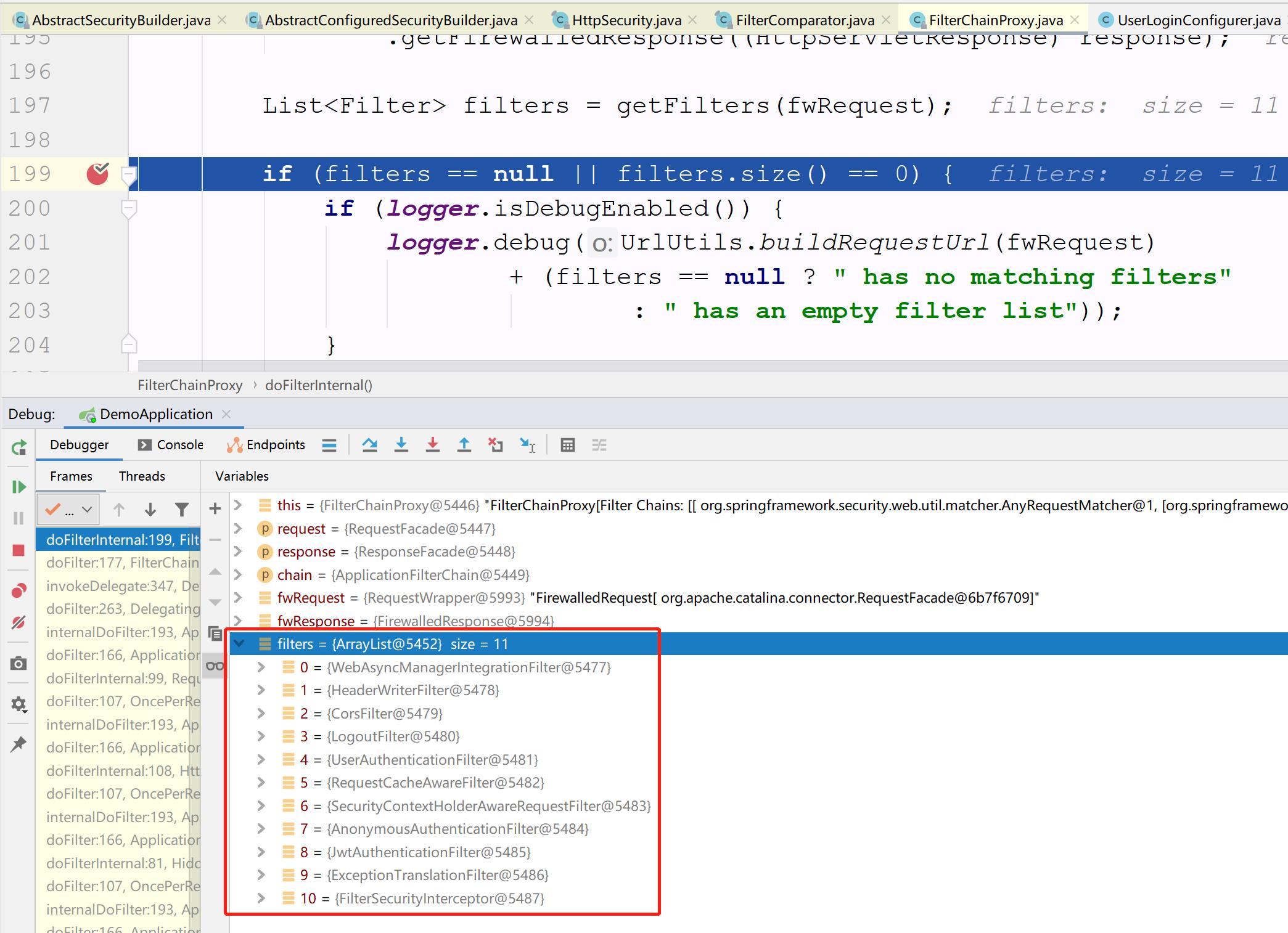Spring Security原理篇(二) 过滤器原理
Posted
tags:
篇首语:本文由小常识网(cha138.com)小编为大家整理,主要介绍了Spring Security原理篇(二) 过滤器原理相关的知识,希望对你有一定的参考价值。
参考技术A 上篇文章通过对 WebSecurityConfiguration 这个配置类的源码阅读,已经了解到,在启动的时候主要创建了两个对象, WebSecurity 和名字为 springSecurityFilterChain 的 Filter 。这篇文章主要是通过源码阅读,查看一下Filter的创建过程,以及后面的工作原理。这里构建了HttpSecurity对象,以及有一个共享对象FilterSecurityInterceptor ,我们还是要将完整的流程讲完,在下一篇文章对HttpSecurity对象做专门的解读,因为这个HttpSecurity对象扮演者非常重要的角色
从上面源码和标注的注释(也许理解不透彻)来看,其实我们只要回答清楚上面的T1,T2,T3这三个问题,就基本弄清楚了。
我们暂时的放过一下 FilterChainProxy ,下一篇我们继续 HttpSecurity
Spring Security源码:过滤器链上的过滤器是如何排序的?
文章目录
一、框架原理
概述
前面源码篇文章(篇尾附上链接)提到,整个框架的核心就是一个过滤器
FilterChainProxy,这个过滤器维护了一组过滤器链,真正起作用的其实是这个过滤器里的过滤器链。我们知道过滤器链可是有执行顺序的,关于它是如何排序的,本篇来聊聊。
过滤器链实战示例
先来看看一个请求进来需要走过的过滤器链有哪些,以下为前面实战篇(篇尾附上链接)中过滤器链debug截图,断点打在核心过滤器
FilterChainProxy的doFilter()上,自行走一下代码,会发现请求需要经过如下过滤器:
可以看到很多熟悉的过滤器,包括我们自己定义的两个过滤器UserAuthenticationFilter、JwtAuthenticationFilter
二、FilterComparator
内部其实是使用这个类来对Filter的实例进行排序,以确保它们的顺序正确。
源码
final class FilterComparator implements Comparator<Filter>, Serializable
private static final int STEP = 100;
private Map<String, Integer> filterToOrder = new HashMap<String, Integer>();
FilterComparator()
int order = 100;
put(ChannelProcessingFilter.class, order);
order += STEP;
put(ConcurrentSessionFilter.class, order);
order += STEP;
put(WebAsyncManagerIntegrationFilter.class, order);
order += STEP;
put(SecurityContextPersistenceFilter.class, order);
order += STEP;
put(HeaderWriterFilter.class, order);
order += STEP;
put(CorsFilter.class, order);
order += STEP;
put(CsrfFilter.class, order);
order += STEP;
put(LogoutFilter.class, order);
order += STEP;
put(X509AuthenticationFilter.class, order);
order += STEP;
put(AbstractPreAuthenticatedProcessingFilter.class, order);
order += STEP;
filterToOrder.put("org.springframework.security.cas.web.CasAuthenticationFilter",
order);
order += STEP;
put(UsernamePasswordAuthenticationFilter.class, order);
order += STEP;
put(ConcurrentSessionFilter.class, order);
order += STEP;
filterToOrder.put(
"org.springframework.security.openid.OpenIDAuthenticationFilter", order);
order += STEP;
put(DefaultLoginPageGeneratingFilter.class, order);
order += STEP;
put(ConcurrentSessionFilter.class, order);
order += STEP;
put(DigestAuthenticationFilter.class, order);
order += STEP;
put(BasicAuthenticationFilter.class, order);
order += STEP;
put(RequestCacheAwareFilter.class, order);
order += STEP;
put(SecurityContextHolderAwareRequestFilter.class, order);
order += STEP;
put(JaasApiIntegrationFilter.class, order);
order += STEP;
put(RememberMeAuthenticationFilter.class, order);
order += STEP;
put(AnonymousAuthenticationFilter.class, order);
order += STEP;
put(SessionManagementFilter.class, order);
order += STEP;
put(ExceptionTranslationFilter.class, order);
order += STEP;
put(FilterSecurityInterceptor.class, order);
order += STEP;
put(SwitchUserFilter.class, order);
public int compare(Filter lhs, Filter rhs)
Integer left = getOrder(lhs.getClass());
Integer right = getOrder(rhs.getClass());
return left - right;
/**
* Determines if a particular @link Filter is registered to be sorted
*
* @param filter
* @return
*/
public boolean isRegistered(Class<? extends Filter> filter)
return getOrder(filter) != null;
/**
* Registers a @link Filter to exist after a particular @link Filter that is
* already registered.
* @param filter the @link Filter to register
* @param afterFilter the @link Filter that is already registered and that
* @code filter should be placed after.
*/
public void registerAfter(Class<? extends Filter> filter,
Class<? extends Filter> afterFilter)
Integer position = getOrder(afterFilter);
if (position == null)
throw new IllegalArgumentException(
"Cannot register after unregistered Filter " + afterFilter);
put(filter, position + 1);
/**
* Registers a @link Filter to exist at a particular @link Filter position
* @param filter the @link Filter to register
* @param atFilter the @link Filter that is already registered and that
* @code filter should be placed at.
*/
public void registerAt(Class<? extends Filter> filter,
Class<? extends Filter> atFilter)
Integer position = getOrder(atFilter);
if (position == null)
throw new IllegalArgumentException(
"Cannot register after unregistered Filter " + atFilter);
put(filter, position);
/**
* Registers a @link Filter to exist before a particular @link Filter that is
* already registered.
* @param filter the @link Filter to register
* @param beforeFilter the @link Filter that is already registered and that
* @code filter should be placed before.
*/
public void registerBefore(Class<? extends Filter> filter,
Class<? extends Filter> beforeFilter)
Integer position = getOrder(beforeFilter);
if (position == null)
throw new IllegalArgumentException(
"Cannot register after unregistered Filter " + beforeFilter);
put(filter, position - 1);
private void put(Class<? extends Filter> filter, int position)
String className = filter.getName();
filterToOrder.put(className, position);
/**
* Gets the order of a particular @link Filter class taking into consideration
* superclasses.
*
* @param clazz the @link Filter class to determine the sort order
* @return the sort order or null if not defined
*/
private Integer getOrder(Class<?> clazz)
while (clazz != null)
Integer result = filterToOrder.get(clazz.getName());
if (result != null)
return result;
clazz = clazz.getSuperclass();
return null;
说明
- 可以看到该类被实例化的时候,就
将框架中存在的过滤器都设置了一个顺序值,保存在filterToOrder。 - 该类还实现了
Comparator接口,实现了它的compare()方法,里面是根据过滤器的顺序值进行排序的。 - 类中提供了一些给外部添加过滤器的接口,比如:
registerBefore(Filter filter, Filter beforeFilter):在beforeFilter过滤器之前添加过滤器。registerAfter(Filter filter, Filter afterFilter):在afterFilter过滤器之后添加过滤器。registerAt(Filter filter, Filter atFilter):加入和atFilter过滤器相同顺序的过滤器。
自定义过滤器顺序设置
- 在登录过滤器配置
UserLoginConfigurer中配置UserAuthenticationFilter过滤器顺序:
@Override
public void configure(B http) throws Exception
UserAuthenticationFilter authFilter = new UserAuthenticationFilter();
authFilter.setAuthenticationManager(http.getSharedObject(AuthenticationManager.class));
authFilter.setSessionAuthenticationStrategy(new NullAuthenticatedSessionStrategy());
// 登录成功处理器
authFilter.setAuthenticationSuccessHandler(new UserLoginSuccessHandler(securityConfig));
// 登录失败处理器
authFilter.setAuthenticationFailureHandler(new HttpStatusLoginFailureHandler());
// 拦截器位置
UserAuthenticationFilter filter = postProcess(authFilter);
http.addFilterAfter(filter, LogoutFilter.class);
- 点进
addFilterAfter()方法查看,其实调用的就是FilterComparator中的方法:
public HttpSecurity addFilterAfter(Filter filter, Class<? extends Filter> afterFilter)
comparator.registerAfter(filter.getClass(), afterFilter);
return addFilter(filter);
三、如何排序
上面小节只是给过滤器加上一个顺序,而对于我们的过滤器链并没有排序,实际上过滤器链还没生成呢,在启动项目的时候才开始创建过滤器,来看看创建过程中是如何对过滤器进行排序的。
实际排序
- 还记得实际上过滤器是在哪创建的吗,在《Spring Security源码(五):FilterChainProxy是如何创建的?》一章中提到过,过滤器是在
HttpSecurity中的performBuild()方法中创建的,可以看到在这里会把已经创建好保存到filters中的过滤器进行排序,其实就是每创建一个过滤器都对过滤器链进行一个排序。
@Override
protected DefaultSecurityFilterChain performBuild() throws Exception
Collections.sort(filters, comparator);
return new DefaultSecurityFilterChain(requestMatcher, filters);
FilterSecurityInterceptor
这是一个特殊的过滤器,特殊在每条过滤器链都是以这个过滤器结尾,这个过滤器是
Spring Security框架做权限访问控制的核心过滤器,请求最后能否通过是否有权限访问后台资源都是由它决定,关于这个过滤器咱们下一篇详细讲解,链接在篇尾。
四、系列文章
Spring Security 系列
- 《手把手教你如何使用Spring Security(上):登录授权》
- 《手把手教你如何使用Spring Security(中):接口认证》
- 《手把手教你如何使用Spring Security(下):访问控制》
- 《Spring Security源码(一):整体框架设计》
- 《Spring Security源码(二):建造者详解》
- 《Spring Security源码(三):HttpSecurity详解》
- 《Spring Security源码(四):配置器详解》
- 《Spring Security源码(五):FilterChainProxy是如何创建的?》
- 《Spring Security源码(六):FilterChainProxy是如何运行的?》
- 《Spring Security源码(七):设计模式在框架中的应用》
- 《Spring Security源码(八):登录认证源码流程》
- 《Spring Security源码(九):过滤器链上的过滤器是如何排序的?》
- 《Spring Security源码(十):权限访问控制是如何做到的?》
Spring Security OAuth 系列
以上是关于Spring Security原理篇(二) 过滤器原理的主要内容,如果未能解决你的问题,请参考以下文章
